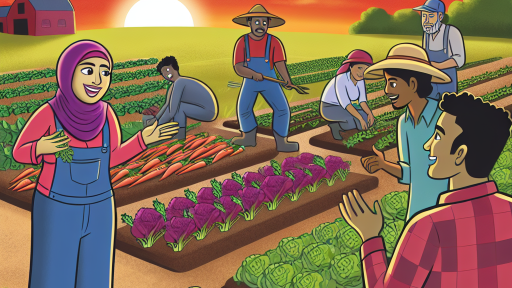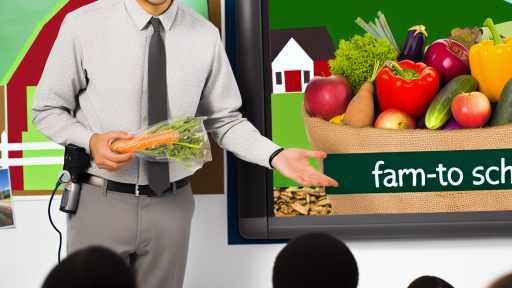Introduction to Local Food Sourcing
Local food sourcing is increasingly recognized for its essential role in agriculture.
It connects consumers directly with farmers in the community.
Moreover, it encourages the growth of sustainable practices.
Local sourcing reduces transportation costs and emissions.
It also promotes fresher produce with higher nutritional value.
In addition, local food sourcing supports local economies.
Community, in turn, becomes more resilient and self-sufficient.
The Importance of Quality and Freshness
Consumers often seek higher quality food options.
Fresh ingredients have superior flavor and nutritional benefits.
Local sources provide seasonal produce, which varies by region.
This contributes to a diverse and healthy diet.
Supporting Local Farmers and Economy
Buying locally helps farmers sustain their livelihoods.
It fosters relationships between producers and consumers.
Moreover, local purchasing keeps money within the community.
This, in turn, creates jobs and investment opportunities in agriculture.
Transform Your Agribusiness
Unlock your farm's potential with expert advice tailored to your needs. Get actionable steps that drive real results.
Get StartedEnvironmental Benefits
Local food sourcing minimizes transportation emissions.
It encourages responsible land use and biodiversity efforts.
Additionally, it helps reduce packaging waste commonly associated with imports.
This creates a more sustainable food system overall.
Identifying Key Challenges in Local Food Sourcing
Availability of Local Products
Local food availability presents significant challenges for food businesses.
Many areas lack a diverse range of food producers.
Consequently, businesses struggle to find the products they need.
This often leads to reliance on non-local suppliers.
Additionally, some producers may not supply consistently.
Seasonality of Produce
Seasonality affects the variety of local foods available.
Different crops grow at different times of the year.
Thus, businesses may face gaps in product availability.
Understanding local growing seasons is essential.
Moreover, adapting menus to align with seasonal offerings can help.
Accessibility Issues
Accessibility remains a crucial barrier in local food sourcing.
Some regions have limited transportation options for food products.
As a result, local producers may struggle to reach consumers.
Urban areas often benefit more than rural locations.
Developing partnerships with logistics providers can improve access.
Strategies for Overcoming Challenges
Various strategies exist to tackle these challenges effectively.
- Establishing strong relationships with local farmers enhances availability.
- Implementing community-supported agriculture can ensure consistent supply.
- Utilizing online platforms aids in connecting producers and consumers.
- Offering education on seasonal foods boosts awareness among consumers.
- Collaborating with local governments can improve transportation infrastructure.
Economic Factors Affecting Local Food Sourcing
Cost Considerations
The cost of sourcing local food often poses significant challenges.
Farmers generally have higher production costs compared to large-scale producers.
Transporting local produce can also increase expenses.
To address these issues, businesses can streamline supply chains.
Showcase Your Farming Business
Publish your professional farming services profile on our blog for a one-time fee of $200 and reach a dedicated audience of farmers and agribusiness owners.
Publish Your ProfileUtilizing community-supported agriculture can help reduce costs.
Additionally, purchasing directly from farmers can lower prices for consumers.
Investing in local food infrastructure also creates cost efficiencies.
Competition with Larger Producers
Local food sources often face competition from larger industrial farms.
These producers benefit from economies of scale, enabling lower prices.
As a result, local farmers must differentiate their offerings.
One effective strategy involves emphasizing the quality and freshness of local produce.
Moreover, marketing local foods through branding can attract consumers.
Collaboration among local businesses can create a stronger market presence.
Consumer Preferences and Awareness
Consumer preferences significantly influence local food sourcing challenges.
Many consumers prioritize convenience and price over local sourcing.
However, increasing awareness about health benefits is shifting preferences.
Educating consumers on the importance of local foods can change buying habits.
Engaging in community outreach programs fosters this awareness.
Furthermore, creating value-added products can appeal to varied consumer tastes.
Promotions and events highlighting local foods can boost interest.
See Related Content: How to Start Direct Sales for Your Farm
Supply Chain Challenges
Infrastructure Issues
Local food sourcing often faces significant infrastructure challenges.
Limited cold storage facilities hinder the preservation of fresh produce.
This results in food spoilage and loss of quality.
Additionally, inadequate road networks impede smooth transportation.
As a result, many regions struggle to access fresh local foods.
Transportation Complexities
Transportation plays a crucial role in local food sourcing.
Many local farms lack reliable transportation options.
This leads to delays in getting produce to market.
Furthermore, rising fuel costs exacerbate these transportation challenges.
Consequently, farmers may choose to sell to larger, distant markets instead.
Distribution Logistics
Distribution logistics remain a significant hurdle in local food systems.
Many local producers lack the expertise to organize effective distribution.
This issue can lead to uneven supply across regions.
Moreover, varying demand for local foods complicates distribution planning.
Addressing these logistics is vital for sustainable sourcing.
Strategies for Overcoming Challenges
To tackle infrastructure issues, stakeholders can invest in local facilities.
This includes building more cold storage options to preserve freshness.
Moreover, improving local road conditions can facilitate better access.
For transportation, establishing partnerships can enhance logistics.
Collaborative efforts between farmers and transport companies may help.
Additionally, utilizing technology for distribution can streamline processes.
Online platforms can connect local producers directly with consumers.
Explore Further: Integrating Seasonal Eating into Your Farming Operation
Showcase Your Farming Business
Publish your professional farming services profile on our blog for a one-time fee of $200 and reach a dedicated audience of farmers and agribusiness owners.
Publish Your ProfileUnderstanding Regulatory Hurdles and Compliance Issues in Local Food Sourcing
Overview of Regulatory Challenges
Local food sourcing faces numerous regulatory challenges.
These challenges often emerge due to differing state and federal laws.
Additionally, local food producers may lack familiarity with compliance requirements.
Understanding these regulations is crucial for success in local sourcing.
Common Compliance Issues
Several compliance issues hinder local food sourcing efforts.
Food safety regulations remain a primary concern among producers.
Producers often struggle to meet the safety standards set by agencies.
Labeling guidelines present another significant hurdle.
Confusion about local versus organic labeling can lead to compliance failures.
Building Relationships with Regulatory Bodies
Establishing relationships with regulatory agencies can ease compliance challenges.
Local food businesses should engage with agencies such as the Department of Agriculture.
Regular communication helps clarify regulations and expectations.
Furthermore, attending workshops can build knowledge of regulatory requirements.
Finding Resources for Compliance
Utilizing available resources reduces the burden of compliance.
Industry associations often provide guidelines and support for local producers.
Networking with other food businesses can also offer valuable insights.
Online courses can teach producers about food safety and compliance standards.
Advocacy for Better Regulations
Advocating for better regulations benefits the entire local food community.
Producers can join forces to address common regulatory challenges.
Collaborative efforts can bring attention to the need for simplified regulations.
Furthermore, sharing success stories with policymakers can influence regulations.
Explore Further: Seasonal Agri-Tourism Ideas for Every Farm

Building Connections with Local Farmers and Producers to Foster Collaboration
The Importance of Relationships
Establishing strong relationships with local farmers is essential for successful sourcing.
These connections can lead to better quality products and reliable supply chains.
Additionally, personal relationships help in understanding the challenges farmers face.
Identifying Local Producers
Start by researching local farms and producers in your area.
Attend farmers’ markets to meet suppliers and learn about their offerings.
Networking events can also connect you with local agricultural groups.
Creating a Supportive Environment
Consider organizing collaborative events with local farmers.
Workshops can educate both farmers and businesses on sustainable practices.
These gatherings foster a sense of community and shared objectives.
Building Trust Through Transparency
Maintain open communication with local producers regularly.
Discuss your needs and expectations clearly to build mutual trust.
Transparency in pricing and sourcing strengthens these business relationships.
Collaborative Marketing Efforts
Partner with local producers to enhance marketing strategies.
Joint promotions can attract more customers for both local businesses and farms.
Leverage social media to highlight these partnerships effectively.
Encouraging Innovation
Encourage local farmers to adopt innovative practices and technologies.
Support programs that provide resources for experimentation and growth.
Innovation leads to better products and improved sustainability.
Showcase Your Farming Business
Publish your professional farming services profile on our blog for a one-time fee of $200 and reach a dedicated audience of farmers and agribusiness owners.
Publish Your ProfileUncover the Details: Sustainable Practices in Farm-to-School Projects
Strategies for Educating Consumers About the Benefits of Local Sourcing
Understanding the Importance of Local Sourcing
Local sourcing supports community economies effectively.
It reduces transportation costs and environmental impact.
Furthermore, local food often has superior freshness and taste.
Additionally, it fosters relationships between producers and consumers.
Utilizing Social Media Campaigns
Leverage social media platforms to spread awareness.
Create engaging content highlighting local producers.
For instance, feature farmer interviews showcasing their practices.
Encourage users to share their local food experiences.
These actions build a community around local sourcing.
Organizing Community Events
Host farmers’ markets to connect consumers directly with producers.
Offer tastings to highlight the quality of local produce.
Additionally, organize workshops teaching cooking with local ingredients.
These events promote local food and educate the community.
Collaborating with Local Restaurants
Partner with restaurants emphasizing local menus.
Encourage them to promote their local sourcing efforts.
Use promotional materials to highlight the benefits of local sourcing.
Such collaborations create a positive image for local foods.
Implementing Educational Programs in Schools
Introduce local food topics in school curriculums.
Organize field trips to local farms for hands-on learning.
Engage students in growing their own food through garden projects.
These initiatives foster an appreciation for local sourcing from a young age.
Creating Informational Resources
Develop brochures and online guides highlighting local food benefits.
Provide statistics on the environmental and economic impacts.
Share recipes that utilize local seasonal produce.
These resources empower consumers to make informed choices.
Innovative Solutions for Local Food Sourcing
Leveraging Technology
Technology plays a vital role in enhancing local food sourcing efficiency.
First, mobile apps help connect consumers with local farmers.
For instance, apps like Farmigo allow users to order fresh produce directly.
Likewise, these platforms streamline the buying process for both parties.
Moreover, tracking tools help consumers find the nearest farms available.
Transitioning to technology reduces food waste significantly.
App Solutions for Farmers
Farmers can utilize specialized apps to manage their inventory better.
For example, software like Cropio offers real-time insights into crop health.
This information assists farmers in making informed decisions quickly.
Additionally, apps enable farmers to analyze market trends effectively.
By using DataFarm, they can adjust pricing based on demand.
Community Engagement Tools
Building a strong community around local food sourcing is essential.
Social media platforms foster connections between consumers and producers.
Farmers can share updates using Instagram or Facebook to engage audiences.
Showcase Your Farming Business
Publish your professional farming services profile on our blog for a one-time fee of $200 and reach a dedicated audience of farmers and agribusiness owners.
Publish Your ProfileMoreover, community-supported agriculture (CSA) programs utilize newsletters.
These newsletters inform subscribers about local produce availability.
Integrating E-commerce Platforms
Another innovative solution involves e-commerce integrations for farmers.
Websites like Local Harvest allow small farms to list their products online.
This exposure enables consumers to shop for local products conveniently.
Furthermore, these platforms offer delivery services to enhance accessibility.
With these tools, farmers can reach a broader audience successfully.
Educational Resources and Training
Providing educational resources enhances local food sourcing efforts.
Workshops and webinars can teach farmers about efficient practices.
Organizations like the USDA offer valuable training sessions to growers.
Furthermore, local extension offices can provide tailored advice.
This support empowers farmers to adopt modern techniques effectively.




